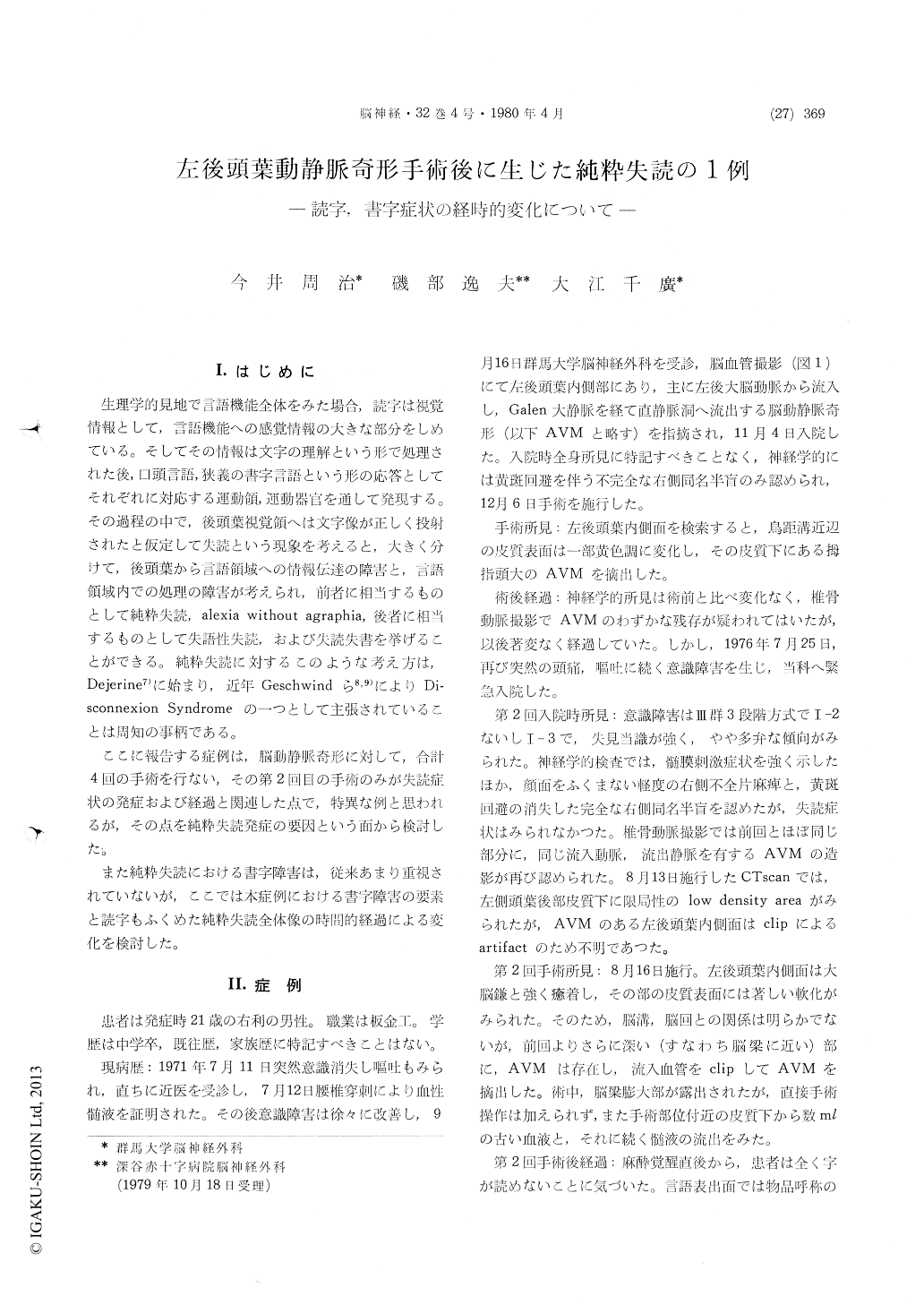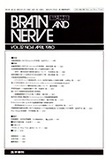Japanese
English
- 有料閲覧
- Abstract 文献概要
- 1ページ目 Look Inside
Ⅰ.はじめに
生理学的見地で言語機能全体をみた場合,読字は視覚情報として,言語機能への感覚情報の大きな部分をしめている。そしてその情報は文字の理解という形で処理された後,口頭言語,狭義の書字言語という形の応答としてそれぞれに対応する運動領,運動器官を通して発現する。その過程の中で,後頭葉視覚領へは文字像が正しく投射されたと仮定して失読という現象を考えると,大きく分けて,後頭葉から言語領域への情報伝達の障害と,言語領域内での処理の障害が考えられ,前者に相当するものとして純粋失読,alexia without agraphia,後者に相当するものとして失語性失読,および失読失書を挙げることができる。純粋失読に対するこのような考え方は,Dejerine7)に始まり,近年Geschwindら8,9)によりDi—sconnexion Syndromeの一つとして主張されていることは周知の事柄である。
ここに報告する症例は,脳動静脈奇形に対して,合計4回の手術を行ない,その第2回目の手術のみが失読症状の発症および経過と関連した点で,特異な例と思われるが,その点を純粋失読発症の要因という面から検討した。
A case of alexia without agraphia was reported. A 21-year-old right handed man suddenly became unconscious on July 11, 1971, and was diagnosed to be subarachnoid hemorrhage due to an arterio-venous malformation (AVM) in the left medial occipital region by vertebral angiography (VAG). When he was admitted to our clinic on November 4, only neurological manifestation was incomplete right homonymous hemianopia with macular sparing. The extirpation of the AVM was per-formed on December 6, and the neurological finding remained unchanged postoperatively, but VAG showed suspicious filling of the residual AVM. The clinical course was uneventful untill he was readmitted in the unconscious state on July 25, 1976. At the time, neurological findings revealed signs of meningeal irritation, mild right hemiparesis and complete right homonymous hemianopia. VAG showed the AVM in the same region as before. At the 2nd operation on August 16, the medial surface of the left occipital lobe showed marked softening but the splenium was exposed without injuries. Immediatelly after the operation, the patient complained of severe reading disability. He could not read any words or letters both in Kana (Japanese phonogram) and Kanji (Japanese ideogram) for about several days. The readingability gradually improved and the facilitation of reading by tracing letters was observed, especially after 10 days postoperatively. Reading errors resulting from morphological similarities were also noticed frequently. The impairment of spontaneous writing and of writing to dictation, on the other hand, was less marked than that of reading, while copied writing was rather worse. Both spontaneous speech and verbal comprehension except for oral naming were normal and agnosic or apraxic dis-orders were not seen. Recent memorey disturbances, however, were remarkable. In order to remove the small rest of the AVM, 3rd operation was carried out but the operation was also unsatisfactory. Progressive improvement of alexia after the 2nd operation, particularly in Kana words, did not deteriorated by the 3rd operation. Comparing with the improvement in Kana, difficulties in Kanji words remained and the amnestic tendency increased both in reading or writing. Lastly the AVM was successfully removed by the 4th operation on March 9, 1977. Three months and a year had passed after the onset of alexia on November 28, 1977, when the reading ability in Kana words became perfect, but that in Kanji was still troublesome probably due to amnestic factors. Morphological reading errors and the facilitation of reading disappeared completely. In writing also, Kanji remained affected while Kana was normal. In both Kana and Kanji, copied writing became normal.
In CT scan on November 1977, abnormal low density area involved the left posterior forceps of the splenium as well as the left medial occipital region, though the splenium had not been damaged by the 2nd operation. And this would cause alexia in this case in spite of the apparent intact splenium in the operation.
In Alexia Without Agraphia, although the writing was thought to be intact as the words meant, it was not perfect in most cases. In the presented case, the writing disability seemed to be composed of two factors, one is visuo-kinetic, the other amnestic, and the latter remained longer.

Copyright © 1980, Igaku-Shoin Ltd. All rights reserved.


